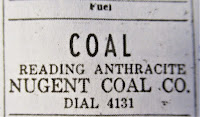W.B. Anglin’s site at Bay and Wellington Streets had excellent road, rail and water access. In 1865, their sawmill opened, and it could turn out 10,000 board-feet of lumber per day. The lumber operation ended in 1979 with closure of the planning mill and custom carpentry shop. A prime supplier of heating and industrial coal, Anglin supplied Queen’s University and Barriefield heating plants, local industries, Kingston Psychiatric Hospital and the Strathcona paper mill, eventually shipping 250,000 tons per year. Well into the 20th-century, Anglin Bay’s docks were piled high with coal. Anglin also brought coal by CP to the W.H. Norman wood yard at 771 Division Street. Even in the 1970’s, some local customers still heated with coal, though with fuel oil becoming a cleaner preferred fuel for industry, home heating followed suit. Sold to Triheat in 1998, for the first time in 130 years in business, there was no longer an Anglin family member associated with the enterprise.
 |
| Anglin ad, 1902 |
Breck and Booth’s coal yard at 300 King Street West at the foot of Beverley Street was established in 1885. Becoming Booth & Company in 1895, operations ceased by 1941.
John Morris took on ownership of the Dennee & Morris Coal Co. in 1961, operating from their site alongside the CP at Ontario Street and Place d’Armes until 1960. Their coal yard on Clarence Street had been demolished for the building of the federal building and post office there in 1956.
William H. Norman Wood and Coal at 771 Division Street was just past the entrance to Gus Marker’s yard. Originally obtaining coal through Swift, Sowards or Anglin, the yard eventually had a CP spur. The yard became the north-end branch of Anglin’s after its purchase by Anglin in the late 1950’s. One of the only coal yards in Kingston with an elevated trestle, theirs was 75 feet long. The property was vacated by 1969.
Harry Rosen began selling coal at 137 Rideau Street in 1937, relocating to 5 Cataraqui Street and enlarging the share of oil sales. The slogan, “Don’t Wait Till You’re Half Frozen – Buy Your Fuel From Harry Rosen” was a familiar sight on oil delivery trucks. Coal sales ended in 1974. Ad from July, 1952:
James Sowards entered the coal business in 1889 with a sizeable coal yard at the north end of Ontario Street at Place d’Armes. Sadly, Sowards died at the yard in 1914 but was succeeded by sons John F. and James A. Sowards. The company operated the steel tow barge White Star and the PatDoris (below, with Richardson elevator) – a 200-foot steam-powered vessel in use between 1924 and the 1940’s. 
The PatDoris brought coal to Kingston from ports on the New York side. Purchased by Anglin’s in 1963, the yard operated under the Anglin’s Coal name until 1979. Sowards’ 230-foot long coal trestle with covered shed was a landmark in that corner of downtown, until it was demolished in the early 1980’s. The Frontenac Village community was built on the site in the early 1980’s. Sowards’ slogan: “Sowards Keeps Coal and Coal Keeps Sowards”.
James Swift established his 300 x 100-foot dock and 150 x 75-foot coal shed at the foot of Johnson Street in 1866. The dock saw passenger vessels, wood and coal shipments and freight warehousing. Sold to J.P. Hanley in 1926, the operation remained in Hanley family hands until the coal enterprise was bought by Richardson’s. Large letters proclaimed “Jas. Swift & Co. Coal” on the shed’s roof, with “Jas. Swift Scranton Coal” on the street side. The coal shed featured an elevator and tripper system to deposit coal in the appropriate bins. A spur was apparently installed, with cement unloading hopper at the shed’s north end. A new Swift office, facing Ontario Street was built in 1947 and demolished in 1970.
Coal dealers advertised on matchbooks:
- S. Anglin at Bay and Wellington Streets hawked “Blue Coal – Tinted Blue for Your Protection”
- Drury at 235 Wellington: “Selling Delaware & Hudson Sterling Coal – Identified by Chemi-Coating”
- Alex MacMeekin of 367 College sold “Lehigh Navigation & Coal Co. – Old Company’s Lehigh Premium Anthracite Coal”
- James Richardson proffered “Favorite Penna. Hard Coal – Your Hudson Coal Dealer – Delaware and Hudson Coal”.






























Thank you this is well done
ReplyDeleteThanks, Peter!
ReplyDeleteEric
Enjoyed seeing ads and articles about Crawford Coal. Robert is my great grandfather.
ReplyDeleteSorry forgot to tell you my name
ReplyDeleteGreat to hear from you, Reg. I was born too late for the age of coal, but I find it interesting how Kingstonians got the coal they needed until oil took over.
ReplyDeleteThanks for your comment,
Eric